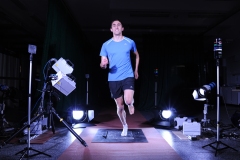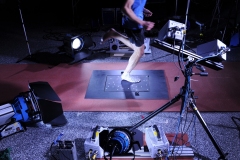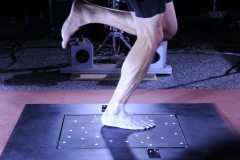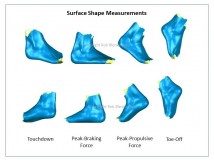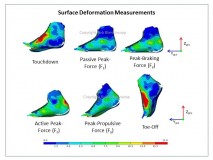Knowledge of the three dimensional shape of the human foot is important in the design of shoes to facilitate correct fit. The measurement of human foot shape has to date, been almost exclusively performed when the foot is stationary. However, the foot is a complex structure, which changes shape during the movements and loadings associated with human locomotion. This is particularly prevalent in sporting activities such as running where the foot can experience multi-axial loads of multiple body weights during the stance phase. More recently, attempts have been made to measure dynamic foot shape, however, measurements have usually been limited in detail as well as restricted to walking gait, as a result of the measurement technology. In addition, no study has related measurements of dynamic foot shape with simultaneous measurements of athlete kinetics and kinematics.
Aim
The aim of this study was to develop a methodology capable of measuring the three dimensional shape and deformation of the human foot at multiple stages during the stance phase of running, which could be correlated with athlete kinetics and kinematics
Approach
- Requirements of measurement system established
- Suitability and validity of Digital Image Correlation (DIC) for measuring foot shape evaluated
- Methodology developed to measure full foot shape surfaces (including the dorsal surface) and associated parameters using the GOM ARAMIS DIC system
- Simultaneous tracking of circular markers placed on anatomical landmarks using GOM PONTOS enabled anatomical segments to be created in accordance with the Oxford foot model
- Use of a glass force plate enabled athlete kinetics to be captured whilst still allowing the dorsal surface of the foot to be imaged
- Repeatability and reproducibility of measurement method evaluated
Key Findings
- A methodology has been developed that employs digital image correlation (DIC) to measure the shape and deformation of the foot
- Twelve strategically placed high-speed cameras, including two beneath a glass force plate, enabled an almost complete surface to be measured between the ankle and MPJ with minimal interpolation
- The developed method also has the capability to measure kinetics via an instrumented glass force platform and to measure kinematics without the need for additional hardware by using the same images captured for DIC.
- Novel material measures were developed to calibrate the DIC system. Using these, shape measurements were calibrated to within ±0.1mm and surface deformations to within ±0.5%strain.
- The methodology has the potential to be applied in a number of research areas related to the measurement of dynamic foot morphology and understanding the change in foot shape during the stance phase of gait. Furthermore, the capability for the measurement of kinetics and kinematics concurrently to dynamic shape measurements also allows the potential for wider applications in understanding the drivers for human foot shape change and potential relationships to injury.
Publications
- Blenkinsopp, R. (2014). A method for measuring human foot shape during running stance. PhD Thesis.
- Blenkinsopp, R, Harland, A, Price, D, Lucas, T, Roberts, J. (2012): “A Method to Measure Dynamic Dorsal Foot Surface Shape and Deformation During Linear Running Using Digital Image Correlation”. Procedia Eng Vol. 34 Pg 266-271.
Researchers

